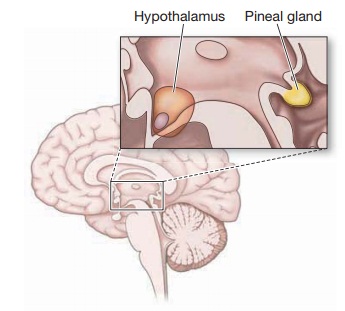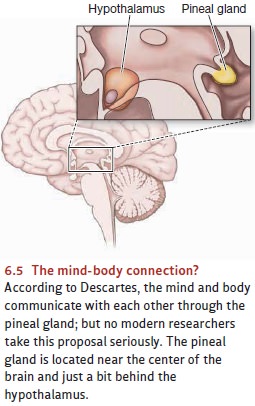Chapter: Psychology: Consciousness
Neural Basis for Consciousness: The Mind-Body Problem

The Mind-Body
Problem
As we noted, the brain is a
physical object: It has a certain mass (about three pounds), a certain
temperature (a degree or two warmer than the rest of the body), and a certain
volume (a bit less than a half gallon). It occupies a specific position in
space. Our conscious thoughts and experiences, on the other hand, are not
physical objects and have none of these properties. An idea, for example, does
not have mass or a specific tem-perature. A feeling of sadness, joy, or fear
has neither volume nor a location in space.
How, therefore, is it possible
for the brain to give rise to our thoughts? How can a physical entity give rise
to nonphysical thoughts and feelings? Conversely, how can our thoughts and
feelings influence the brain or the
body? Imagine that you want to wave to a friend, and so you do. Your arm, of
course, is a physical object with an iden-tifiable mass. To move your arm,
therefore, you need some physical force. But your ini-tial idea (“I want to
wave to Jacob”) is not a physical thing with a mass or a position in space.
How, therefore, could your (nonphysical) idea produce a (physical) force to
move your arm?
The puzzles in play here all stem
from a quandary that philosophers refer to as the mind-body problem. This term refers to the fact that the mind (and
the ideas,thoughts, and feelings it contains) is an entirely different sort of
entity from the physical body—and yet the two, somehow, seem to influence each
other. How can this be? Roughly 400 years ago, the philosopher René Descartes
(1596–1650) confronted these issues and concluded that the mind and the body
had to be understood as entirely different species of things, separate from
each other. The mind, in his view, was defined by the capacity for thought
(Descartes’ term was res cogitans—“thing
that thinks”); the body, on the other hand, was defined by the fact that it had
certain dimensions in physical space (res
extensa—“extended thing”).

Descartes knew, however, that
mind and body interact: Physical inputs (affecting the body) can cause
experiences (in the mind), and, conversely, thoughts (in the mind) can lead to
action (by the body). To explain these points, Descartes proposed that mind and
body influence each other through the pineal gland, a small structure more or
less at the center of the brain (Figure 6.5). This is the portal, he argued,
through which the physical world communicates sensations to the mind, and the
mind communicates action commands to the body.
Modern scholars uniformly reject
Descartes’ proposed role for the pineal gland, but the mystery that Descartes
laid out remains. Scientists take it for granted that there’s a close linkage
between mind and brain; one often-quoted remark simply asserts that “the mind
is what the brain does”. But, despite this bold assertion, we truly do not know
how the physical events of sensation give rise to conscious experiences or how
conscious decisions give rise to physical move-ments. We can surely talk about
the correspondence between the
physical and mental worlds—what physical events are going on when you
experience “red” or “sad” or “anxious”—but we do not yet have a
cause-and-effect explanation for how these two worlds are linked.
Related Topics